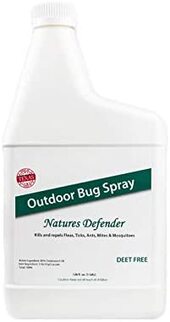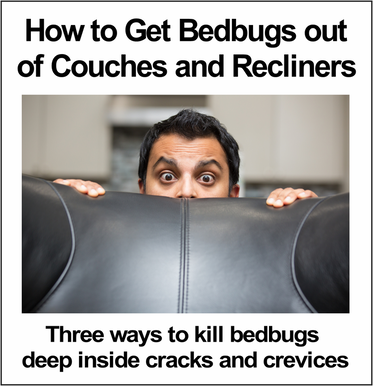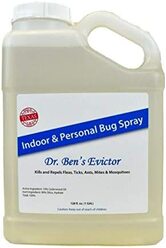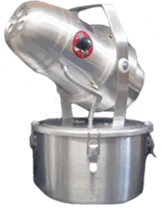Ten Rules to Avoid Transferring Mites when Moving to a New House
1. Don't use cardboard boxes!
Mites can get in and out of cardboard boxes. If your packed moving boxes were stored in a mite infested home as you prepared to move, it's a good bet that some of them have mites inside. Choose plastic storage tubs instead.
2. Wipe each storage tub with bleach before taking it into the new house.
Your storage tubs may have to sit around your house for weeks or months as you prepare to move. Don't risk bringing mite covered tubs into your new home. Place a large tarp on the lawn in front of your new place. Saturate a rag with bleach or alcohol. Wipe down each side of each tub before bringing the tubs into your new space. Don't forget to wipe the bottom of each tub!
3. Properly wash clothing and blankets before packing and transferring.
|
A bird mite can live nine months without a blood meal. If you began packing unwashed items near the beginning of your infestation, you could easily transfer mites to your new residence when you open the boxes. Washing Instructions: White items can be bleached. Colored items can be soaked in Borax. If borax doesn't seem to be working, and you still feels sensations in your clothes after they've been laundered, try adding a cap full of PCO Choice to your soak water. For more than 20 years, pet owners and veterinarians have trusted this product to wash and soak animals afflicted with mites. The formula can also be added to laundry water to help kill mites in the wash. Detergents and hot water alone don't always kill parasites in the laundry. When scabies outbreaks occur in nursing homes and other institutions where bedridden patients have no skin-to-skin contact, the laundry is usually blamed for transmission. Over a twelve year period, I have received thousands of phone calls from frustrated callers who claim that they can feel things pricks and movement coming from parasites like bird mites or springtails in laundered clothing that comes straight out of the dryer. As a general rule, infested laundry should be soaked for an hour in Boax before washing. A cap full of Vet's Choice Concentrate can be added along with the Borax. When soaking thick items such as blankets and sweaters, add two caps of Vet's Choice Concentrate.
|
4. Discard the following items. Don't bring them to your new home!
- Throw Rugs (Rugs make it difficult to spray, vacuum and perform daily maintenance rituals connected to mite eradication.)
- Throw Pillows (Mites can burrow deep into fabric items. It's impossible to kill them without soaking the item in pesticides.)
- Cardboard Boxes (Mites can EASILY get in and out of cardboard boxes. Store all of your excess items in air tight plastic bins.)
- Live Plants (Depending on what type of micro tiny invader is bothering you, it may like to eat decaying leaves or breed in the soil.)
- Old Clothes! (Unless you plan on soaking them in PCO and storing them in PLASTIC air tight containers, get them out of your life.
- Wicker Laundry Baskets. (Mites can easily move in and out of the spaces. Store dirty and clean laundry in air tight plastic bins.)
- Old Toys. (Since toys should be sterilized on a regular basis, now is a good time to get old or unwanted items out of the mix.)
5. Don't enter your new home wearing shoes and clothing you wore at your infested home.
Keep a storage box with clean shoes outside your new home. Step out of your old shoes outside the door. You may even wish to keep a ziplock bag with extra clothing outside your new home.
6. Solve skin and scalp issues before moving.
7. Solve car infestations before moving.
8. Don't bring infested couches and beds to your new home.
9. Spray floors, carpets couches and furniture at BOTH HOMES.
|
10. Don't move to a new home with carpeting!
Carpeting is a major reason why bird mite, rodent mite and springtail infestations tend to be chronic. If mites have infested BELOW carpeting, no amount of spraying or steam cleaning will reach them. You may have to remove carpeting and thoroughly fog each room before you can sell your old home.
Do you need to fog the old home? It depends on the type of mite you're battling.
|
Below you will find a list of the top ten mites that bother humans. Only a few mites on the list tend to be chronic. Fogging is an aggressive agenda for serious or chronic mite infestations. The mist settles on walls, ceilings and other surfaces that traditional spray programs don’t reach. To determine if fogging is necessary, consult the following list.
|
- Dust Mites: Rest assured that these microscopic mites are not responsible for the crawling or biting sensations that may be keeping you awake at night. A fogging protocol is not necessary. Simply spray carpets, couches and bedding with Dr. Ben's Evictor. Vacuuming is not enough, as dust mites are known for their ability to cling to carpet and bedding fibers. Dust mites do not bite humans or pets. They feed upon pet dander and skin flakes that humans shed naturally. When dust mite waste becomes airborne, it can cause allergic reactions such as sneezing, runny nose, watery eyes, itchy hives, asthma and various breathing difficulties. If you're allergic to dust mite waste, a UV air filter can make all the difference in the world. Such filters use UV light to kill contaminants that are drawn into the unit. We do not sell air filters, but we've included product recommendations near the end of this article.
- Demodex Mites: Demodex mites are normal skin residents in virtually all mammal species. For the most part, these microscopic organisms live in hair follicles and don't cross from pets to humans or vice versa. In rare cases, humans can be sensitive to dog Demodex mites (Demodex canis or Demodex ingal) or cat Demodex mites (Demodex cati and Demodex gatoi). Fogging is not necessary, as Demodex mites can't live away from hosts for more than a few days, depending upon room temperature and humidity. Most humans have their own demodex mites (Demodex folliculorum and Demodex brevis). When demodex populations grow out of control, it can cause hair loss, acne, rosacea, itchy eyes, swollen eyelids and crusty eyelashes. To treat Demodex mites on the head, saturate your hair and scalp with Dr. Ben's Evictor and leave the solution in place for a few hours. To treat the face, dab a bit of the Evictor onto your fingertips or apply with a cotton ball. You cannot treat eyes or eyelashes with Dr. Ben's Evictor, but you can dab a bit on eyebrows. Ask your dermatologist for steroid eye drops or use a Q-tip to apply castor oil along your lash line. Blepharitis is a common eye condition that can make eyelids red, swollen or itchy. The Demodex mite can cause blepharities by carrying streptococci and staphylococci bacteria to the eye area.
- Grain Mites (Straw Itch Mites): These common parasites of insects tend to infest stored cereal, rice, corn meal, dried beans, peas, straw and hay. They normally pray upon insects but will also bite humans. Thankfully, grain mites don't remain on humans for long or burrow into human skin. Fogging is not necessary unless you need to eradicate a host insect that has brought grain mites into your home. In residential spaces, grain mites are typically associated with pantry staples and stored pet foods. Problems tend to resolve quickly when infected foods are discarded and surfaces are disinfected Dr. Ben's Evictor. In barns, grain mites can infest straw and hay. It's a heartbreaking situation, as the hay fed to horses is quite expensive, and it cannot be sprayed with chemicals or essential oils.
- Scabies Mites: A fog machine is not necessary, as the human scabies mite doesn't travel far from the human host. Frequent spray treatment of skin, couches and bedding will be required. Special laundry practices are mandatory. Learn more about laundry treatment at this link. Doctor's visits will be required to monitor skin.
- Cheyletiella Mites: This mite is sometimes called the walking dandruff mite due to the appearance of white flakes that move along with the mites. Fogging is useful for this type of infestation. Skin treatment will also be necessary, as the cheyletiella mite can burrow down into the superficial keratin layer of skin. Spray skin, bedding, carpets and furniture with Dr. Ben's Evictor.
- Bird Mites: Fogging is often necessary for this type of infestation, as bird mites tend to spread all over the house. In addition to congregating inside couches or air ducts, they may be found climbing up walls or dispersing across ceilings. For this reason, a good fog machine may be necessary to help pest control fluids settle upon walls, coat ceilings and penetrate unseen crevices. Most bird mite clients come to me after hiring pest control operators and failing with typical spray protocols.
- Rodent Mites: Fogging is often necessary for this type of infestation because rodent mites tend to hide behind walls and emerge in large numbers when rodents die from various poisons that were used to eradicate them. Most clients come to me after hiring pest control operators and failing with typical spray protocols.
- Springtails: Springtail infestations are among the most chronic and difficult to treat because these organisms are often connected to mold issues behind walls or under floors. In addition to floor treatment and furniture treatment, fogging is often necessary to take down the numbers. Yard treatment is often useful because many springtail cases begin after dumping new landscaping materials on the property. Springtails are also connected to mold and moisture issues around the foundation, especially after floods.
- Chiggers: Chiggers are tiny mites that live outdoors in grassy or wooded areas near water. They can be red, orange or yellow in color. The larval stage of the mite is the only parasitic stage. Adults do not bite. They thrive in warm temperatures, especially during humid periods in the summer. If chiggers get into your home by accident, they won't survive long. Fogging is not necessary, but you may want to spray skin and bedding during the short duration of their reign.
- Oak Mites: Oak mites are microscopic insects that live in oak trees and feed upon small midget fly larvae.The oak mite bite can create red welts that are sometimes misdiagnosed as chigger bites. The good news is that you don't have to fumigate the house or throw your mattress away. Oak mites can't survive without the bug larvae they feed upon. If they accidentally get into your home via trees located near windows, they won't live long. If oak mites have become a problem on your property, it helps to spray clothing and skin with Dr. Ben's Evictor before going out to do yard work. Spraying trees won't do much good, as these mites are protected within oak galls, unsightly brown balls that grow from branches or look like hanging fruit.






